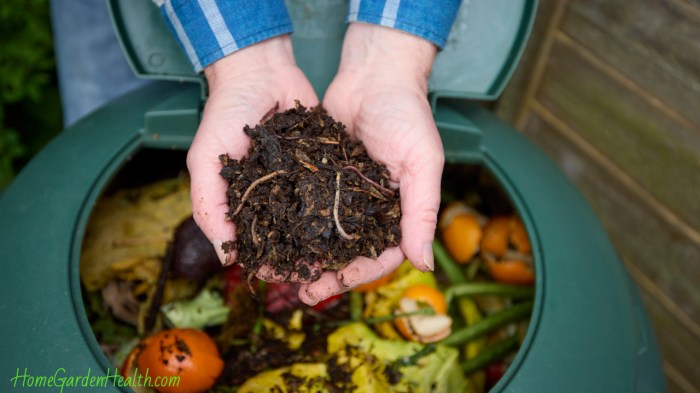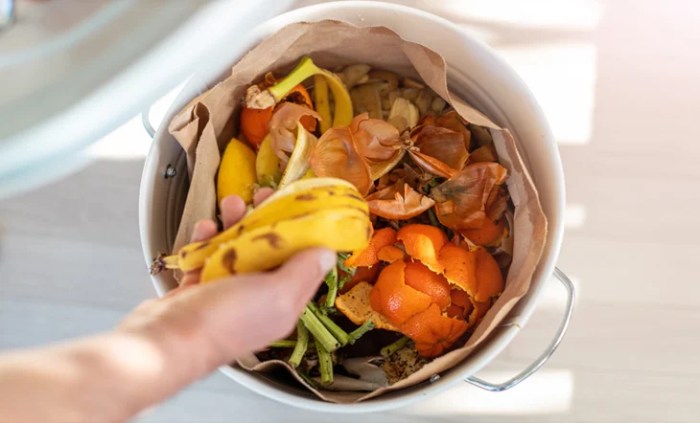
Composting at home opens a door to sustainable living, turning kitchen scraps and yard waste into nutrient-rich soil. It’s not just about reducing waste; it’s about enriching your garden and contributing positively to the environment.
This guide will take you through the essentials of starting your composting journey, highlighting the benefits, methods, and maintenance tips to help you transform your home into an eco-friendly haven.
Introduction to Composting at Home

Composting is the natural process of recycling organic matter, such as food scraps and yard waste, into a valuable fertilizer for gardening. This method not only contributes to a healthier garden but also supports sustainable living by reducing waste. By integrating composting into home gardening, individuals can significantly improve soil quality and plant health while minimizing their environmental footprint.The benefits of composting at home are manifold.
First and foremost, it drastically reduces the amount of waste that ends up in landfills. Instead of discarding organic waste, homeowners can convert it into nutrient-rich compost, enriching their soil and encouraging plant growth. Additionally, composting enriches the soil by adding essential nutrients and improving its structure, which can help retain moisture and reduce the need for chemical fertilizers.
Benefits of Composting
The advantages of composting extend beyond the garden, impacting the environment positively. Composting helps reduce greenhouse gas emissions by minimizing the volume of waste that decomposes anaerobically in landfills, a process that releases methane, a potent greenhouse gas. Here are some key benefits:
-
Reduction of landfill waste: Composting diverts organic materials from landfills, where they would otherwise take years to decompose.
-
Soil enrichment: Compost adds organic matter, improving soil aeration, structure, and moisture retention.
-
Reduction of chemical fertilizers: Enriching soil with compost reduces the reliance on synthetic fertilizers, promoting a healthier ecosystem.
-
Support of local biodiversity: Compost encourages healthy microbial and earthworm populations, contributing to a balanced ecosystem.
Composting at home also fosters a sense of community and responsibility. Many individuals find joy in sharing their composting experiences and the resulting bounty from their gardens with neighbors, promoting a culture of sustainability. This simple act not only enhances individual gardens but also nurtures the environment, creating a ripple effect that can inspire others to join in the movement towards a greener lifestyle.
Setting Up a Composting System

Creating a composting system at home is a fantastic way to reduce waste and create nutrient-rich soil for your garden. Whether you’re a seasoned gardener or a beginner, setting up a compost bin is an eco-friendly project that’s both rewarding and straightforward. This guide will help you gather the essential materials, build your compost bin using recycled materials, and choose the right location for your compost pile.
Essential Materials for Starting a Compost Bin
To begin composting effectively, it’s important to gather the right materials. Here’s a list of essential components for your compost bin:
- Carbon-rich materials (Browns): These include dry leaves, straw, shredded paper, and cardboard. They provide the necessary carbon for the composting process.
- Nitrogen-rich materials (Greens): This category includes vegetable scraps, fruit peels, coffee grounds, and grass clippings. These materials are crucial for providing nitrogen.
- Water: Moisture is essential to help the microbes break down the materials. Aim for a damp consistency similar to a wrung-out sponge.
- Air: Aeration is key to the composting process. Turning your compost regularly introduces oxygen, which is necessary for aerobic decomposition.
- A compost bin or designated area: This could be as simple as a pile in your yard or a more structured bin made from pallets or other materials.
Building a Compost Bin Using Recycled Materials
Creating a compost bin doesn’t have to be a costly endeavor. You can use recycled materials to build a functional compost bin. Here’s a step-by-step guide to building your own compost bin:
- Gather materials: Collect wooden pallets, old fencing, or even wire mesh. Ensure the materials are untreated to avoid introducing harmful chemicals.
- Decide on a size: A bin that is 3 feet wide by 3 feet deep is an ideal size for effective composting. Adjust the size according to your available space.
- Construct the bin: Arrange the pallets or fencing in a square shape, securing them together at the corners. If using wire mesh, create a circular structure and secure it with stakes.
- Add a lid (optional): While not necessary, a lid can help retain moisture and heat. Use a piece of wood or a tarp to cover your bin.
- Fill the bin: Start adding your carbon and nitrogen materials in layers, mixing them to promote aeration and speed up decomposition.
Choosing the Right Location for a Compost Pile
The location of your compost pile can greatly affect its efficiency. Here are some key factors to consider when selecting a spot:
- Accessibility: Choose a location that is easy to reach for adding materials and turning the compost.
- Sunlight: Ideally, your compost pile should receive a mix of sun and shade. Sunlight helps to heat the pile, accelerating decomposition, while shade helps retain moisture.
- Drainage: Ensure the site has good drainage to prevent water from pooling. A slightly elevated area or one with loose soil is ideal.
- Proximity to your garden: Placing your compost bin close to your garden can make it easier to transport finished compost to your plants.
- Avoiding pests: Choose a location away from your house to minimize the risk of attracting pests. Keeping the bin covered can also help mitigate this issue.
Types of Composting Methods
Composting at home can be accomplished through various methods, each with its unique characteristics and benefits. Understanding these different types allows you to choose the best system for your lifestyle, available space, and gardening goals. This section will explore traditional pile composting, tumblers, and vermicomposting, highlighting the pros and cons of each.
Traditional Pile Composting
Traditional pile composting involves creating a heap of organic materials in a designated area of your yard or garden. This method requires minimal investment and can handle large volumes of waste.Pros:
- Low cost, as it requires no specialized equipment.
- Can process a significant amount of organic waste.
- Encourages microbial activity, resulting in rich compost.
Cons:
- Requires a larger space, making it less suitable for small yards or urban settings.
- Takes longer to decompose, typically several months to a year.
- Needs regular turning and monitoring of moisture levels.
Ideal Scenarios:Traditional pile composting works best for homeowners with ample outdoor space, such as rural or suburban properties, where they can accumulate large amounts of organic waste.
Tumbler Composting
Tumbler composting utilizes a rotating bin that allows you to mix the compost ingredients easily. This method is popular among those seeking a more efficient way to compost.Pros:
- Faster composting process, often reducing time to just a few weeks.
- Compact design suitable for limited spaces.
- Less effort required in turning the compost.
Cons:
- Higher initial cost due to equipment purchase.
- Limited capacity compared to traditional piles, which may not suit larger operations.
- Requires regular monitoring to maintain the right balance of materials.
Ideal Scenarios:Tumbler composting is ideal for urban dwellers with small yards or balconies who still want to compost efficiently without taking up too much space.
Vermicomposting
Vermicomposting involves using worms, specifically red wigglers, to break down organic materials. This method is particularly effective for indoor composting.Pros:
- Produces nutrient-rich compost (vermicompost) quickly, within weeks.
- Minimal space requirement; can be done in bins under the sink or on a balcony.
- Odor-free when maintained properly, making it suitable for indoor use.
Cons:
- Requires ongoing care and maintenance to keep worms healthy.
- Limited processing capacity; not ideal for large amounts of waste.
- Higher initial setup costs for bins and worms.
Ideal Scenarios:Vermicomposting is excellent for apartment dwellers or those with limited outdoor space who still wish to recycle kitchen scraps effectively.
“Choosing the right composting method can significantly enhance your gardening efforts and reduce waste in your home.”
Composting Materials
Composting is both an art and a science, particularly when it comes to choosing the right materials to include. The success of your compost pile largely hinges on the balance of different organic materials you incorporate. Understanding the categories of composting materials—greens and browns—makes it easier to create nutrient-rich compost that can nourish your garden.To achieve a balanced compost, it’s essential to combine nitrogen-rich “greens” with carbon-rich “browns.” Greens are typically fresh and moist, providing the crucial nitrogen that helps the compost break down.
On the other hand, browns are more dry and woody, supplying the carbon necessary for energy during the composting process. Striking an ideal balance between these two categories is vital to ensure efficient decomposition and to avoid issues like odor or slow breakdown.
Suitable Composting Materials
Composting can effectively utilize a variety of household items. Below is an organized list of suitable materials categorized into greens and browns, which will enhance the quality of your compost.
Greens are rich in nitrogen and include:
- Fruit scraps (peels, cores)
- Vegetable scraps (stems, leaves)
- Grass clippings
- Coffee grounds and filters
- Eggshells
- Green garden waste (fresh leaves, stems)
Browns are rich in carbon and consist of:
- Dry leaves
- Straw or hay
- Wood chips or sawdust (untreated)
- Pine needles
- Cardboard and paper (non-glossy)
- Dried plant trimmings
Maintaining a carbon-to-nitrogen ratio of about 30:1 will lead to optimal composting conditions.
Balancing the right amount of greens and browns not only accelerates the decomposition process but also helps to eliminate odor and prevent pests. A well-maintained compost pile, rich in diverse organic materials, can transform kitchen waste and yard debris into a valuable resource for your garden, thereby supporting a sustainable lifestyle.
Maintaining Your Compost
Maintaining your compost is a crucial step in ensuring that your organic waste decomposes efficiently, resulting in rich, nutrient-dense compost for your garden. Regular attention to aeration, moisture levels, and addressing any issues that arise will promote a healthy composting environment.One of the key aspects of maintaining compost is the process of turning and aerating the material. This helps to introduce oxygen into the compost pile, which is essential for aerobic decomposition.
Without proper aeration, the compost can become compacted, slowing down the breakdown process. Turning the compost also helps to mix materials, ensuring that everything decomposes evenly.
Aeration and Turning Compost
Turning your compost pile regularly is important for promoting healthy decomposition. Aim to turn your compost every few weeks, depending on the size and temperature of the pile. When turning compost, follow these guidelines:
- Use a pitchfork or compost aerator to lift and turn the materials, ensuring the outer layers are mixed into the center.
- Check the temperature of the compost; if it’s too cool, it may need more turning to increase airflow.
- Aerate more frequently if the compost appears dense or soggy, which can indicate a lack of oxygen.
Maintaining the right moisture levels is also vital for effective composting. Compost should ideally feel like a damp sponge—not too wet or too dry.
Moisture Levels in Compost
Understanding moisture levels will help you achieve the right balance in your composting system. Here are some tips to maintain ideal moisture:
- If the compost is too dry, add water gradually while turning the pile to evenly distribute moisture.
- For overly wet compost, incorporate dry carbon-rich materials like dry leaves or shredded newspaper to absorb excess moisture.
- Using a moisture meter can help monitor levels, providing a more accurate reading of your compost’s moisture content.
Occasionally, composting problems may arise, such as unpleasant odors or pest infestations. Addressing these issues promptly will keep your compost healthy and manageable.
Common Composting Problems
Recognizing and resolving common composting problems can simplify the process significantly. Here are some troubleshooting tips:
- For unpleasant odors, check the carbon-to-nitrogen ratio; a balance of 30:1 is ideal. If the pile smells, it may be too wet or too rich in nitrogen. Turning the compost and adding carbon materials can help.
- In case of pests like fruit flies or rodents, ensure you are not adding meat, dairy, or oily foods, as these attract unwanted critters.
- If you notice that the compost is not heating up, it may be too compacted or lacking in nitrogen. Turn the pile to aerate it and consider adding more green materials.
“Maintaining a balanced compost pile is essential for producing high-quality compost that nourishes your soil.”
Using Finished Compost
Finished compost is a nutrient-rich amendment that can do wonders for your garden and landscaping. Knowing when your compost is ready for use, and how to properly integrate it into your gardening routine, can significantly enhance your soil health and plant growth. The transformation from kitchen scraps and yard waste to a dark, crumbly material is a rewarding aspect of composting that many gardeners cherish.To identify when your compost is ready, look for a few key indicators.
Finished compost should be dark brown or black, crumbly in texture, and have an earthy smell. It is also important to ensure that the original materials are no longer recognizable. A simple test involves taking a handful of compost; if it holds together when squeezed and breaks apart easily when touched, it’s ready for application.
Incorporating Compost into Garden Beds and Pots
Integrating finished compost into your garden beds or pots is crucial for enhancing soil fertility. There are several effective methods to do this, each suited for different gardening styles and types of plants.
1. Top Dressing
Spread a thin layer of finished compost on the soil surface around established plants. This method allows nutrients to seep into the soil with watering or rainfall.
2. Soil Amendment
Mix finished compost into the soil before planting. This is ideal for new garden beds or when planting new plants. Aim for a 20-30% compost ratio to maintain soil structure while adding nutrients.
3. Potting Mix
Blend finished compost with potting soil for container plants to provide essential nutrients and improve moisture retention. A good mix ratio is 1 part compost to 3 parts potting soil.
4. Compost Tea
Create a nutrient-rich liquid fertilizer by steeping finished compost in water for a few days. This compost tea can be used to water plants, providing an immediate nutrient boost.
Benefits of Applying Compost to Lawn Care and Landscaping
Using compost in lawn care and landscaping offers numerous benefits that can transform your outdoor spaces. By incorporating compost, you improve soil structure, enhance nutrient availability, and stimulate microbial activity.
Soil Health
Compost improves soil structure, allowing for better aeration and water retention, which is vital for healthy grass growth.
Nutrient Source
It provides a slow-release source of nutrients, reducing the need for chemical fertilizers and promoting a more sustainable lawn care practice.
Disease Resistance
Healthy soil enriched with compost can improve plant health and resistance to diseases, resulting in a more robust lawn.
Environmental Impact
Using compost reduces the need for synthetic chemicals and helps recycle organic waste, contributing positively to environmental health.In summary, finished compost is not just a byproduct of composting; it is a valuable resource for enhancing both garden beds and lawns. By recognizing its readiness and understanding effective incorporation methods, gardeners can greatly benefit from this rich, organic material.
Home Furniture and Compost Impact
Composting at home not only benefits the environment by reducing waste but also influences the decisions we make about the materials we choose for our home furnishings. As more individuals embrace eco-friendly living, the integration of compostable materials into furniture design is becoming increasingly popular. This shift reflects a broader commitment to sustainability and an awareness of the environmental impacts associated with furniture production and disposal.The movement towards sustainable furniture is supported by the availability of a variety of compostable materials that can be utilized in the manufacture of home furnishings.
By opting for these materials, consumers can significantly reduce their carbon footprint while also contributing to the reduction of landfill waste.
Compostable Furniture Materials
Choosing furniture made from compostable materials not only aligns with green living practices but also showcases creativity and innovation in home design. Here are some examples of materials and types of furniture that can be created using compostable resources:
- Bamboo: A rapidly renewable resource, bamboo can be used to create sturdy furniture such as chairs, tables, and cabinets. Its lightweight nature and strength make it an excellent choice for sustainable home decor.
- Recycled Paper: Furniture made from compressed recycled paper, like tabletops or shelving units, demonstrates a successful use of waste materials. This type of furniture can often be composted after its lifespan.
- Natural Fibers: Materials such as hemp or organic cotton can be used in upholstery and cushions. These fabrics are biodegradable and can decompose naturally, reducing their environmental impact.
- Wood from Sustainable Sources: Furniture crafted from reclaimed wood not only reduces waste but can also be composted once it has reached the end of its life cycle. This practice adds character and history to home furnishings.
Incorporating composting into your lifestyle extends beyond waste management; it promotes a holistic approach to living sustainably. When selecting furniture, consider how the materials align with your overall green living philosophy. Choosing compostable options encourages manufacturers to prioritize environmentally friendly practices, ultimately influencing the market towards more sustainable products.
“Composting at home represents a commitment to sustainability that can also define our choices in home design.”
Additionally, when designing a green home, integrating composting systems can serve as a focal point. For instance, creating a designated compost space in your kitchen or garden can inspire the use of eco-friendly furniture, such as a compost bin made from recycled materials that complements your aesthetic while promoting sustainability. This synergy of function and design fosters a lifestyle that values ecological responsibility and creativity.
Integrating Composting with Heating and Air Conditioning
Composting at home offers numerous benefits, not only for your garden but also for your indoor environment. By integrating composting practices with your heating and air conditioning systems, you can enhance indoor air quality, boost energy efficiency, and even reduce heating costs through improved insulation. Understanding this relationship can lead to healthier living spaces and more sustainable energy use.The process of composting generates heat as organic materials break down, contributing to a slight increase in ambient temperature around the compost bin.
This aspect can be utilized positively within your home’s heating and cooling systems. Properly maintained compost can also help regulate humidity levels, which is essential for indoor air quality. By ensuring your composting setup is optimal, you can enjoy a range of advantages related to your home’s climate control.
Impact on Indoor Air Quality and Energy Efficiency
Composting can significantly enhance indoor air quality by reducing the need for chemical fertilizers and by facilitating a natural degradation process that minimizes odors. This leads to fresher and cleaner air in your home. Here are several ways composting can improve energy efficiency and air quality:
- Reduction of Harmful Emissions: Composting organic waste reduces methane emissions associated with landfill disposal, contributing to a cleaner environment.
- Natural Fertilizer: Utilizing compost indoors can decrease reliance on synthetic fertilizers, which can emit volatile organic compounds (VOCs) that degrade air quality.
- Humidity Control: Maintaining a compost system that is adequately aerated and balanced can help regulate moisture levels, preventing excess humidity that can lead to mold growth.
Maintaining Temperature and Humidity Balance
Achieving a healthy balance of temperature and humidity in your composting system is crucial for efficient decomposition and indoor climate management. Here are several strategies to ensure optimal conditions:
- Regular Monitoring: Use a compost thermometer to monitor internal temperatures and ensure they stay within the ideal range of 130°F to 160°F (54°C to 71°C).
- Aeration: Turn your compost regularly to introduce oxygen, which helps maintain temperature and promote aerobic bacteria that thrive in warm, humid environments.
- Moisture Management: Aim for a moisture content of about 40-60% in your compost. If it’s too dry, add water or green materials; if too wet, incorporate dry leaves or straw.
Compost as Insulation for Energy Savings
The use of compost can also serve as an effective insulation material, potentially reducing heating costs in your home. When incorporated into garden beds or even directly into the soil around your home, compost acts as a thermal mass, retaining heat during cooler months. This can help moderate temperature fluctuations and reduce the energy needed for heating.
“Research indicates that homes insulated with organic materials like compost can lower energy costs by up to 15% annually.”
Incorporating compost into your home environment not only promotes healthy ecosystems but also contributes to energy efficiency and improved indoor air quality. By integrating your composting practices with heating and air conditioning considerations, you can create a more sustainable living space that benefits both you and the planet.
Home Inspections and Composting
During a home inspection, various elements are evaluated to ensure the safety and compliance of the property. Composting systems, often viewed through the lens of sustainability, can also come under scrutiny. Understanding what inspectors look for regarding composting practices can help homeowners prepare their composting systems accordingly.Home inspectors typically assess composting systems to determine if they adhere to local regulations and safety standards.
They will check for proper placement, functionality, and maintenance of the composting setup. A compliant composting system prevents pest infestations and unpleasant odors, which are common red flags during inspections.
Factors Inspectors Evaluate in Composting Systems
Inspectors focus on several key factors to ensure that a composting system is safe and compliant. Here are some essential points they consider:
- Location: Compost bins should be placed away from structures and property lines to minimize potential fire hazards and odor issues.
- Material Management: Inspectors check the types of materials being composted. Certain items, like meat and dairy, can cause issues and are often not recommended for home composting.
- Bin Condition: The structural integrity of the compost bin is vital. Inspectors look for damages or signs of deterioration that could lead to leaks or pest problems.
- Pest Control Measures: Effective pest management strategies, such as using enclosed bins or regularly monitoring the compost, are essential to prevent infestations.
Maintaining a compliant composting system involves following best practices. Homeowners should regularly monitor their compost, ensuring the right materials are used and that the compost is turned and aerated properly.
Preparing for a Home Inspection with a Composting System
When preparing for a home inspection that includes a composting system, homeowners should take proactive steps to ensure compliance. Here are some suggestions to create a favorable impression:
- Documentation: Keep local composting regulations and guidelines accessible. Inspectors appreciate when homeowners are knowledgeable about compliant practices.
- Cleanliness: Regularly clean the compost area and surrounding space to avoid any buildup of unwanted materials or odors.
- Bin Maintenance: Ensure that the compost bin is in good condition. Repair any damages and maintain an organized setup to reflect the system’s functionality.
- Odor Control: Implement strategies to manage smells effectively, such as adding carbon-rich materials like dried leaves or straw to balance nitrogen-rich food scraps.
By being aware of what home inspectors evaluate and maintaining a compliant composting system, homeowners can ensure a smoother inspection process and promote sustainable practices within their residences.
House Plans and Composting Spaces
Integrating composting into your home design can enhance sustainability while promoting an eco-friendly lifestyle. Whether you are building a new home or renovating an existing space, planning for composting is an essential step toward reducing waste and enriching your garden soil. Thoughtful incorporation of composting areas not only benefits the environment but also complements your overall home aesthetics.When considering composting spaces in your house plans, it’s vital to think about accessibility, functionality, and visual appeal.
Designated composting areas should be strategically placed to ensure easy access while blending seamlessly with your landscaping. This can help maintain the beauty of your outdoor spaces without compromising on practicality.
Designing Composting Areas
Creating an effective composting area requires balancing function and design. Here are some ideas to consider when planning your composting space:
- Hidden Compost Bins: Utilize decorative privacy screens or wooden slats to conceal compost bins from view while ensuring they remain easily accessible. This design maintains the visual appeal of your yard.
- Raised Compost Beds: Elevated compost bins can be integrated into garden beds, allowing for easy turning of materials. This method not only saves space but also provides a more organized look.
- Incorporating Planters: Use vertical gardening techniques by attaching compost bins to the sides of planter boxes. This maximizes space, especially in small urban settings, while keeping composting materials within reach.
- Rainwater Collection Systems: Integrate compost bins with rainwater collection systems to manage moisture levels naturally. This is an environmentally friendly approach that enhances both compost and garden health.
Maximizing Space in Small Homes
For urban dwellers or those with limited outdoor space, there are creative strategies to incorporate composting. Small homes can benefit from the following ideas:
- Countertop Compost Bins: Use stylish countertop compost bins designed to fit in kitchens without taking up much space. These bins can be emptied into a larger outdoor compost system later.
- Portable Composters: Consider using portable composters that can be moved around your yard or balcony, allowing flexibility while managing composting materials.
- Shared Community Composting: Engage with neighbors to create a community composting system. This approach maximizes collective space and encourages collaboration among residents.
- Indoor Worm Bins: Reducing space constraints can be countered with indoor worm bins, which are compact and can produce nutrient-rich vermicompost without requiring outdoor space.
Integrating composting into house plans not only contributes to sustainable living but also enhances your home’s aesthetic appeal.
Ending Remarks
In conclusion, embracing composting at home is a rewarding endeavor that fosters a healthier environment while enhancing your gardening experience. By following the guidelines and choosing the right methods, you can enjoy the fruits of your labor while contributing to a more sustainable future.
FAQ Corner
What can I compost at home?
You can compost kitchen scraps like fruit and vegetable peels, coffee grounds, and eggshells, as well as yard waste like grass clippings and leaves.
How long does it take for compost to be ready?
Generally, compost can take anywhere from 3 months to a year to fully mature, depending on the materials used and the method of composting.
Can I compost meat or dairy products?
It’s best to avoid composting meat and dairy, as they can attract pests and create odors. Stick to plant-based materials for best results.
How do I know if my compost is healthy?
Healthy compost should have a pleasant earthy smell, be dark and crumbly, and have a balanced mix of wet and dry materials.
What should I do if my compost smells bad?
If your compost smells bad, it may be too wet or have too many nitrogen-rich materials. Add more browns like dry leaves or cardboard to balance the mixture.







